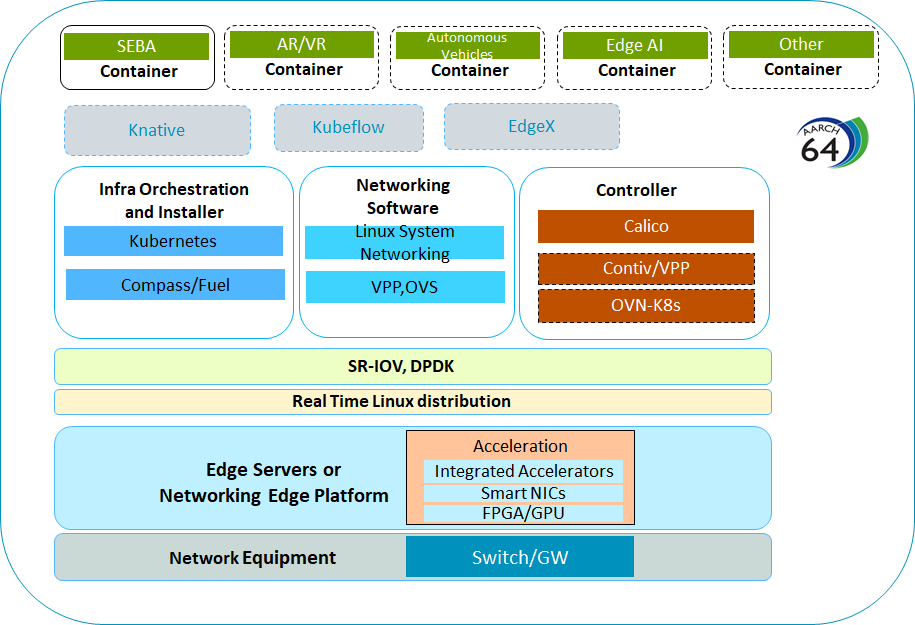This document covers both Integrated Edge Cloud Type 1 & 2.
Integrated Edge Cloud(IEC) is an Akraino approved blueprint family and part of Akraino Edge Stack, which intends to develop a fully integrated edge infrastructure solution, and the project is completely focused towards Edge Computing. This open source software stack provides critical infrastructure to enable high performance, reduce latency, improve availability, lower operational overhead, provide scalability, address security needs, and improve fault management. The IEC project will address multiple edge use cases and industry, not just Telco Industry. IEC intends to develop solution and support of carrier, provider, and the IoT networks.
Use Case
The first use case of IEC is SDN Enabled Broadband Access(SEBA) on arm, in the future more use cases would be added with the provisional plan, such as REC, Edge AI, vCDN, Autonomous Vehicles, and so on.
Where on the Edge
Business Drivers
The Integrated Edge Cloud (IEC) will enable new functionalities and business models on the network edge. The benefits of running applications on the network edge are - Better latencies for end users - Less load on network since more data can be processed locally - Fully utilize the computation power of the edge devices.
Overall Architecture
Currently, the chosen operating system(OS) is Ubuntu 16.04 and/or 18.04. The infrastructure orchestration of IEC is based on Kubernetes, which is a production-grade container orchestration with rich running eco-system. The current container network interface(CNI) solution chosen for Kubernetes is project Calico, which is a high performance, scalable, policy enabled and widely used container networking solution with rather easy installation and arm64 support. In the future, Contiv/VPP or OVN-Kubernetes would also be candidates for Kubernetes networking.
The high level design of IEC architecture uses containerized networking environment:
The edge applications run as containers with container orchestration engine and high performance networking support;
The integrated edge cloud platform provides management interface and programming interface to deploy/manage edge applications quickly and conveniently
The platform supports the applications of IoT gateway, SD-WAN, edge AI and etc.
Under the current architecture, 2 kinds of use cases are supported:
Telco/enterprise Edge cloud – for example, MEC or branch office data center…
Telco/enterprise remote edge locations – edge platform with limited resources, for example, SD-WAN, IoT gateway…
The IEC reference stack architecture is given with the following figure:
Fig 1 IEC Reference Stack
Currently, IEC provides the following functions under its reference architecture:
- The IEC supported hardware are edge servers mainly based on arm64, such as Huawei Taishan, Marvell ThunderX, Ampere Arm64 servers; at the far edge, the supported edge end devices would be Marvell MACCHIATObin Double Shot or other arm based boxes/devices. The desired network connections are above 10Gbit/s which may satisfy most current IEC applications requirement.
- The installation scripts which deploys Kubernetes cluster, Calico CNI, Helm/Tiller and related verifying Kubernetes applications/services with 1 master and 2 slave nodes. The scripts can be run from the jumpserver, or with manual installation from the servers on which it run. The installation methods is introduced in IEC Blueprints Installation Overview.
- Currently IEC uses project Calico as the main container networking solution which provides high performance, rich network policy, widely supported from Linux system and easy installation. In the future, Contiv/VPP and OVN-Kubernetes can be used as a high performance substitute since those 2 solutions can support DPDK enabled high speed interface access.
- IEC support Akraino CI/CD requests: IEC Daily jobs (scheduled to run recurrently) deploy IEC using one of the agreed installers; run testing suites; collect logs and publish them.
- IEC Type1&2 is building 2nd CI/CD validation lab and pushing logs to Akraino Nexus server.
- Currently IEC suppors the SDN Enabled Broadband Access(SEBA) as its first use case. The installation scripts for SEBA on arm and its related source repositories are developed and/or integrated in IEC source code repo. We had ported SEBA components to arm64 servers with Helm chart installation support
